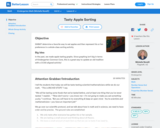
Students apply their knowledge of the order of operations to simplify numerical expressions for a second day.
- Subject:
- Mathematics
- Material Type:
- Lesson Plan
- Provider:
- BetterLesson
- Date Added:
- 12/01/2022

Students apply their knowledge of the order of operations to simplify numerical expressions for a second day.

This lesson builds a foundation for adding larger numbers which is supported by the Common Core standards for second grade.

SWBAT count to ten and identify numbers by counting object patterns.

Patterns are everywhere. We can use patterns to help us deal with larger numbers

Are there patterns in nature that can be described by numbers? That is what we will find out here.

Students love to talk about pets and in this lesson they can share how many pets they have.

What do students already know about integers, rational numbers, and the coordinate plane? What gaps do students have in their understanding? Students take the Unit 3 pretest in order to inform instruction.

Practicing math problems is a great way to study for a math test!

Sorting is an important foundational skills for kindergarten students to learn. Using attribute blocks to sort by shape helps students practice comparing objects and prepares them to sort measurable attributes.

Students are inspired by the Button Box to find different ways to sort their own buttons, including by shape.

Sorting is an important foundational skills for kindergarten students to learn. Using attribute blocks to sort by size helps students practice comparing objects and prepares them to sort by other measurable attributes.

SWBAT use a ten frame to build and identify the numbers 10 through 15.

Subtraction problems can involve shapes, attributes and perimeter.

In the past, we made apple tasting graphs. Since graphing isn't big in terms of Kindergarten Common Core, this is a great way to update an old tradition with a CCSS-aligned activity!

The big idea of this lesson is that students can solve for near doubles by thinking of the related doubles fact.

This lesson provides an opportunity for visual learns to think about segments of time during the school day.

As the result of a Unit assessment, it was found that students showed some confusion with writing time and with adding sets of coins. These skills need to be reviewed to aid in mastery of the Common Core standards for time and money.

This lesson is the sequel to Towers! Towers! Towers! 1-5. Students continue to develop their sense of quantity as they build successive taller towers.

Students develop their understanding of multiplication by grouping objects into equal groups to model the factors and products.

Using a tape diagram is one of the key models for ratios and proportions.